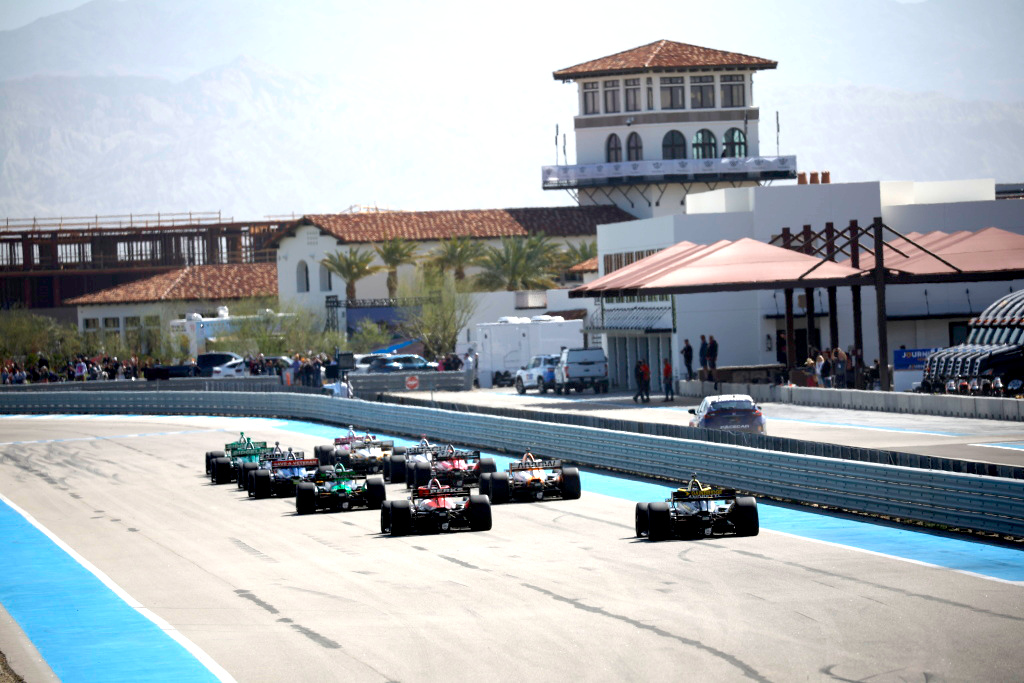If IndyCar and The Thermal Club choose to hold another $1 Million Challenge non-points all-star race, what kind of changes might the series consider to make the format more entertaining from start to finish? Andretti Global’s Colton Herta, Arrow McLaren team principal Gavin Ward and Meyer Shank Racing podium finisher Felix Rosenqvist shared the following with RACER after the inaugural event’s conclusion.
“Qualifying,” Herta said. “Standing start from pit out, single-car qualifying. Just see who can get around to the start/finish line the fastest. This is not my idea. [Team Penske president] Tim Cindric said this. And I agree; that sounds awesome. That’s fun.”
Herta has an idea which has roots in rallycross.
“Turn 1 to Turn 6, there’s a road that connects it. Joker lap,” he said with a big smile. “If we’re gonna do gimmicks, you might as well go all the way through the whole thing. So if you add more of these things, it might make the racing a lot better. Add more gimmicks and make it an awesome all-star attack race. The last thing would be push-to-pass with no response [from the following driver].”
Like Herta, Ward started with qualifying where IndyCar made a limited duration of push-to-pass available for the first time.
“I think for starters, with the qualifying format, if you’re gonna allow overtake to be used, having more than enough overtake so you can do more than one lap with overtake would have been nice,” he said.
Ward’s next topic was the race itself and the split 10-lap segments where drivers were limited to using the same set of tires — on a track where they dealt with extremely high tire degradation — that inspired the bottom half of the 12-car field to cruise at the back and save their tires during the opening stanza.
“I was definitely pretty happy with the performance of our cars, but it’s still pretty hard to make much progress in the race format,” he said. “Not being able to change to new tires at halftime really lent itself to a lot of people trying to save tires because you effectively knew you were gonna get paid back a bunch in the last 10 laps. We need to put some thought into how we can avoid that, because for the 10 laps to start the race, it was not terribly exciting.”
Only race winner Alex Palou was able to maintain a quick pace and prevent his tires from being rooted before the 20 laps were complete. Ward knows why.
“The track layout, to be honest, makes it so you’re going to destroy your tires by following people through high-speed corners due to the understeer it creates, so leading is probably the best tire-saving strategy,” he explained. “But if you’re at the back, there’s almost no penalty to driving slowly in the corners to save the tires for the last stint.”
[lawrence-auto-related count=3 category=1408]
With the steep drop off in prize money after the $50,000 for fifth place, where sixth place through last earn the same $23,000 apiece, Ward provided the answer on why his lead driver on the day — Alexander Rossi, who placed seventh — didn’t go wild trying to improve one or two positions before the checkered flag.
“The thing is, you only incentivize racing in the top six because everyone else gets the same prize,” he said. “So down in seventh, poor Rossi was like, ‘Oh, we could be under pressure here from Newgarden (who ended up eighth),’ but we’re like, ‘Well, doesn’t matter.’”
Rosenqvist likes the idea of making the bisected 20-lap finale an all-skate.
“We all had an open mind going into it, but I thought, overall, it was successful,” he said after bringing $250,000 to MSR. “The biggest thing for me is all cars should race in the main race, There’s no real reason why we wouldn’t have all the cars out there. Maybe the heat race guys who transfer are the only ones who can go for the money, but I think it sucks for the guys who don’t make it (into the final 12). I think part of IndyCar is that you can go from the back to the front.
“Maybe everyone should be out there racing — I think maybe part of why people thought it was a bit stale. If you have more cars it’s more excitement, more variables and strategy. The push-to-pass stuff was pretty interesting — something to learn from for our real events as well. Maybe the Fast Six should have push-to-pass. I thought it was fun trying that kind of stuff; it was a fresh experience.”
One question raised by quite a few folks was why a live pit stop for refueling wasn’t used instead of the 10-minute halftime where they were topped up to be able to complete the last 10 laps. Asked if a pit stop and a new set of tires is something he’d be in favor of, Rosenqvist likes half of the concept.
“Even if the first part of the race was a bit boring,” he said. “I actually like that Colton, for example, had a massive charge in the second part of the race because he was like, ‘I’m just gonna scrap my first part of race and save tires.’ It’s easy to be ‘Captain Hindsight’ but I think actually it was pretty interesting that way with only the one set of tires. I do think pit stops are always a huge contributor to excitement.”
The Swede hopes to share his thoughts with the series on how a future all-star race, if it were held, might be improved.
“We’ll talk to IndyCar about it,” he said. “I think it’s really cool that they had the balls to do something like this.”
